The Jurassic Coast has to be one of the most stunning coastlines of Britain. Starting at Exmouth in East Devon and ending at Old Harry Rocks near Swanage in Dorset, there’s a lot to discover along these 95 miles of pristine waters and iconic towns. In this post, we’re taking you to Dorset, in the area of Lulworth Cove and Durdle Door. Whether you’re visiting for a day, weekend, or whole week, you’ll find a great variety of places to explore in the land of dinosaurs, fossils and castles.
The Jurassic Coast is England’s only natural World Heritage Site famous for its rugged coastline and geology that dates back 185 million years in Earth’s history. While Lulworth Cove and Durdle Door are the reason most people visit this particular area in Dorset, there are many more places we’re going to show you to explore, that offer breathtaking views and photo opportunities.
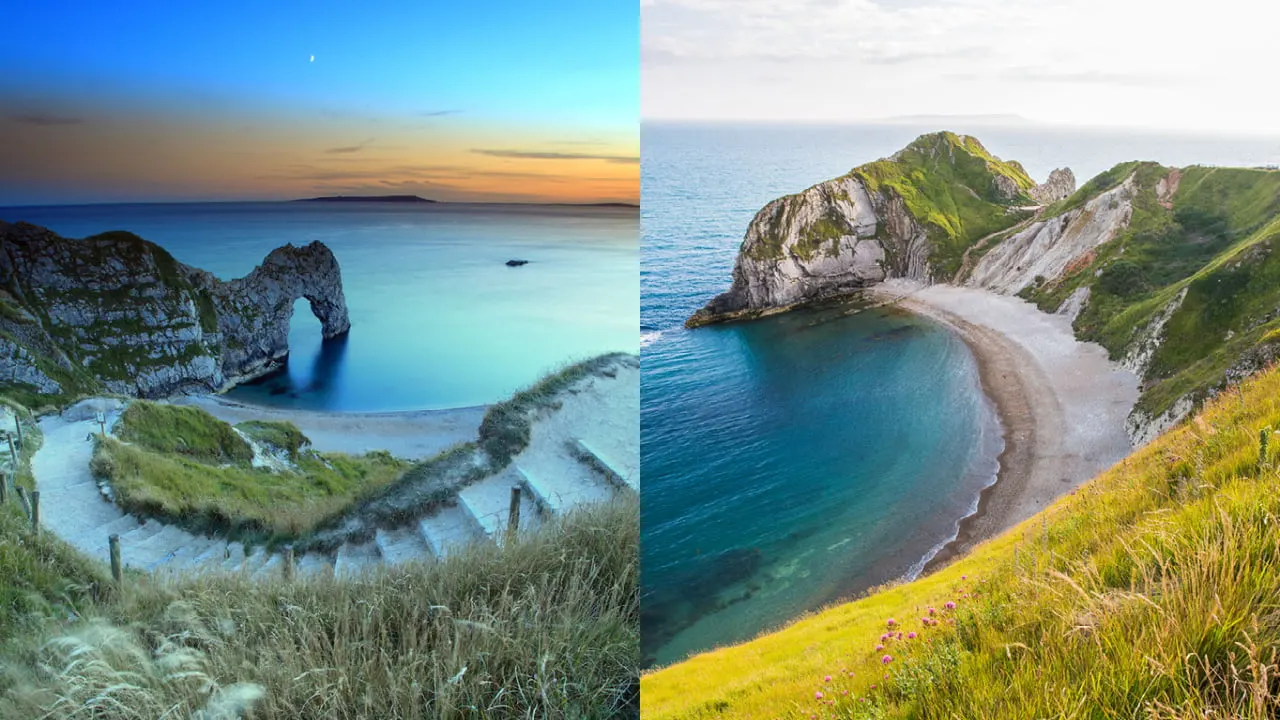
The Lulworth Coastline offers some of the best views of Jurassic and Cretaceous rocks for the geology buffs. Journey along the footpaths from west to east and walk to White Nothe, Bat’s Head, Durdle Door, Man O War, Stair Hole, Lulworth Cove, Fossil Forest and Mupe Bay.
Disclaimer: Hi! this post may contain affiliate links which will take you to online retailers that sell products and services. If you click on one and buy something, I may earn a commission, see my Affiliate Disclosure for more details.
From picture-perfect postcard villages to jaw-dropping beaches and scenic coastal walks with towering cliffs, you’re sure to be swept away by the charm and history of the Jurassic Coast. We’ll show you how to make the most out of your trip to Lulworth Cove and all the surrounding areas that you can walk, hike or drive to.
Tip: There are large car parks at both Lulworth Cove and Durdle Door. You can drive to both locations and park or walk along the coast.
East & West Lulworth
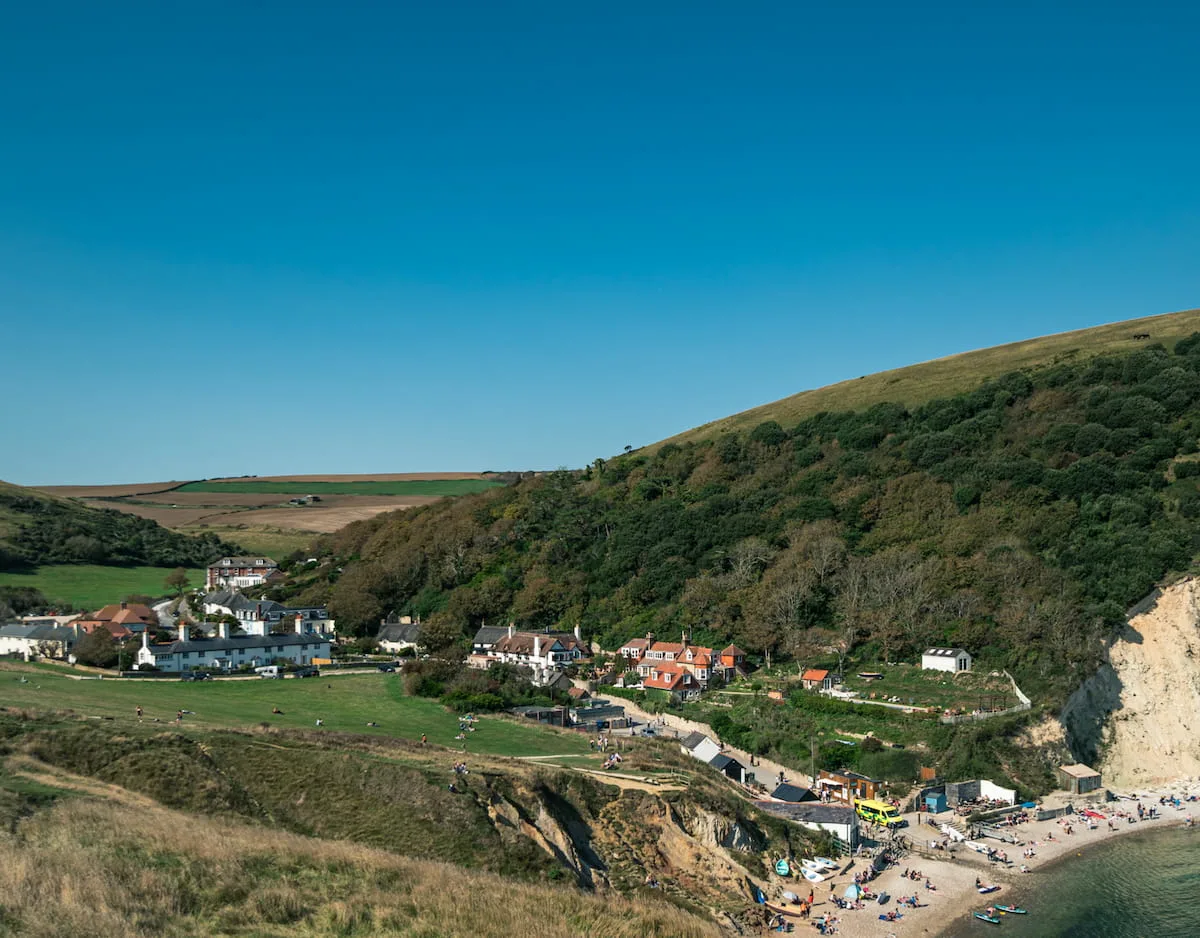
The village of Lulworth is quintessentially English, with East Lulworth being home to an array of charming thatched cottages in the rolling hills just outside Lulworth Castle. West Lulworth is where you’ll find Lulworth Cove, the Visitor’s Centre and an array of independently owned pubs, restaurants and shops. This is where you’ll want to stop if you fancy some fish and chips while overlooking the cove.
Lulworth Castle & Park
Lulworth Castle is deemed to be the most beautiful castle in the south and it’s actually quite impressive. It was originally built as a hunting lodge to entertain royalty in the 18th century but was then destroyed by a fire in 1929. It’s now been partially restored in partnership with English Heritage.
On the grounds sits an 18th-century Catholic Chapel that I recommend seeing for the amazing ceiling mural. There’s also a children’s playground, the Castle Tearoom and extensive woodland walks to enjoy. The castle is closed in the winter so make sure and check their website for opening times.
Lulworth Cove
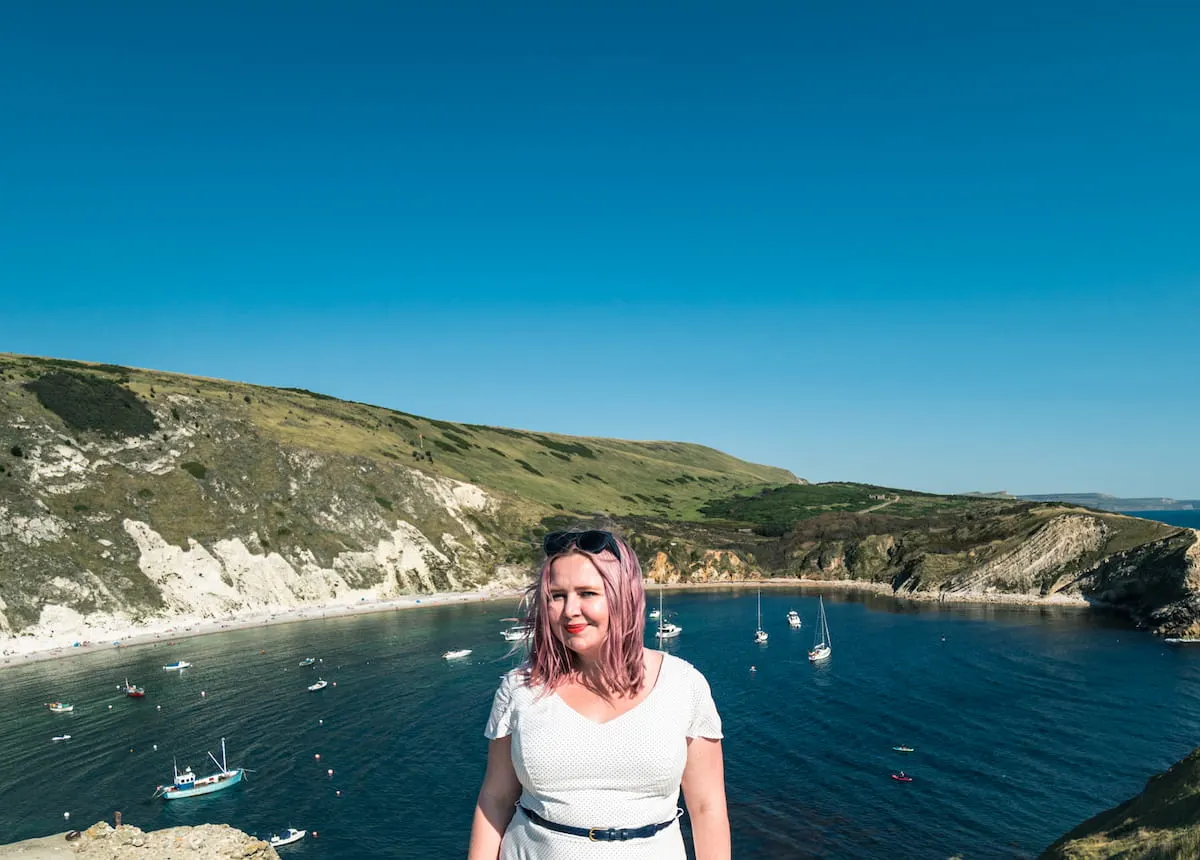
Lulworth Cove is world-famous for its unique geology and landforms, not to mention its breathtaking scenery and blue seas. People travel from around the world to study the Lulworth Crumple and Stair Hole; stunning landforms created by the sea, a river and weather eroded the rocks in this area. The cove forms an almost perfect circle and you’ll find there are quite a few boats that dock here. For the best views, climb up onto the headlands on either the left or right side.
Fossil Forest
If you climb up the headlands on the east side of Lulworth Cove, you’ll be able to check out the Fossil Forest. This is the site of an ancient submerged forest, which grew 150 million years ago when the sea level dropped. Sea levels then rose again during the Earth’s last warm period, around 125 million years ago.
As the Earth warmed, the ancient forest was flooded, killing all the plant life that had colonised this area of the coast. However, when the trees died during this time, their trunks and roots were preserved in the rock that we can see today! You’ll be able to see the surreal evidence of the round curves of the trees in the rock.
Scenic Coastal Walks
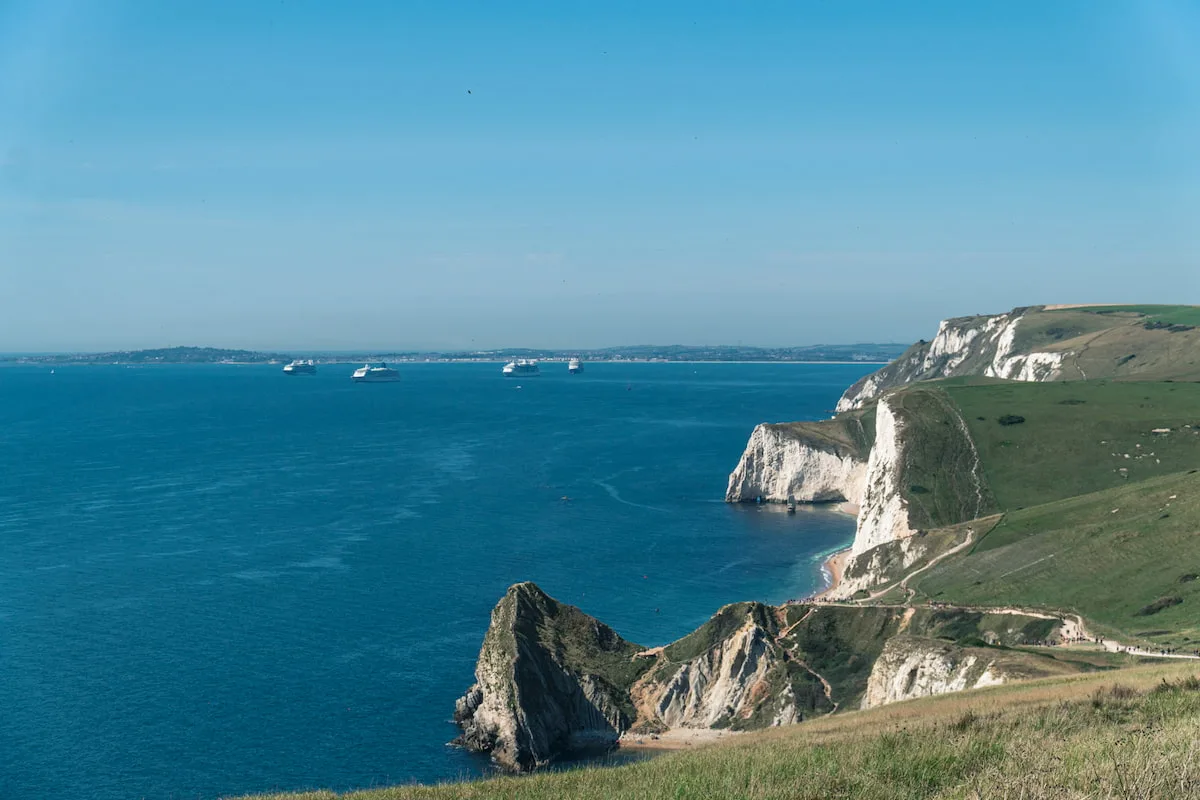
The region of Dorset offers so many beautiful walking routes with epic panorama views. Wander the cliffsides and discover hidden bays and caves as you explore the Jurassic Coast.
One of the best walking routes in the Lulworth area goes from Lulworth Cove and over the cliffs to Durdle Door. The route is 2.5 miles and takes about 2 hours. Although there is some uphill walking, it’s a pretty easy journey along the coast for all ages and abilities. I’d recommend parking at Durdle Door, walking to Lulworth Cove for lunch, maybe a bit of shopping and walking back to break up the day a bit.
For a longer, more challenging walk, take the 7-mile circular route of Durdle Door and White Nothe. Though it is challenging, it’s a walk that will your breath away. These paths have been trodden by people since the Stone Age!
You’ll have spectacular views over the chalk stacks and arches that were once carved by the sea in Jurassic times. It’s especially nice in late Spring and early summer when the path is full of flowers and butterflies. And feel free to take your pup along as they are allowed on the beaches at Durdle Door and Lulworth Cove throughout the year.
Durdle Door
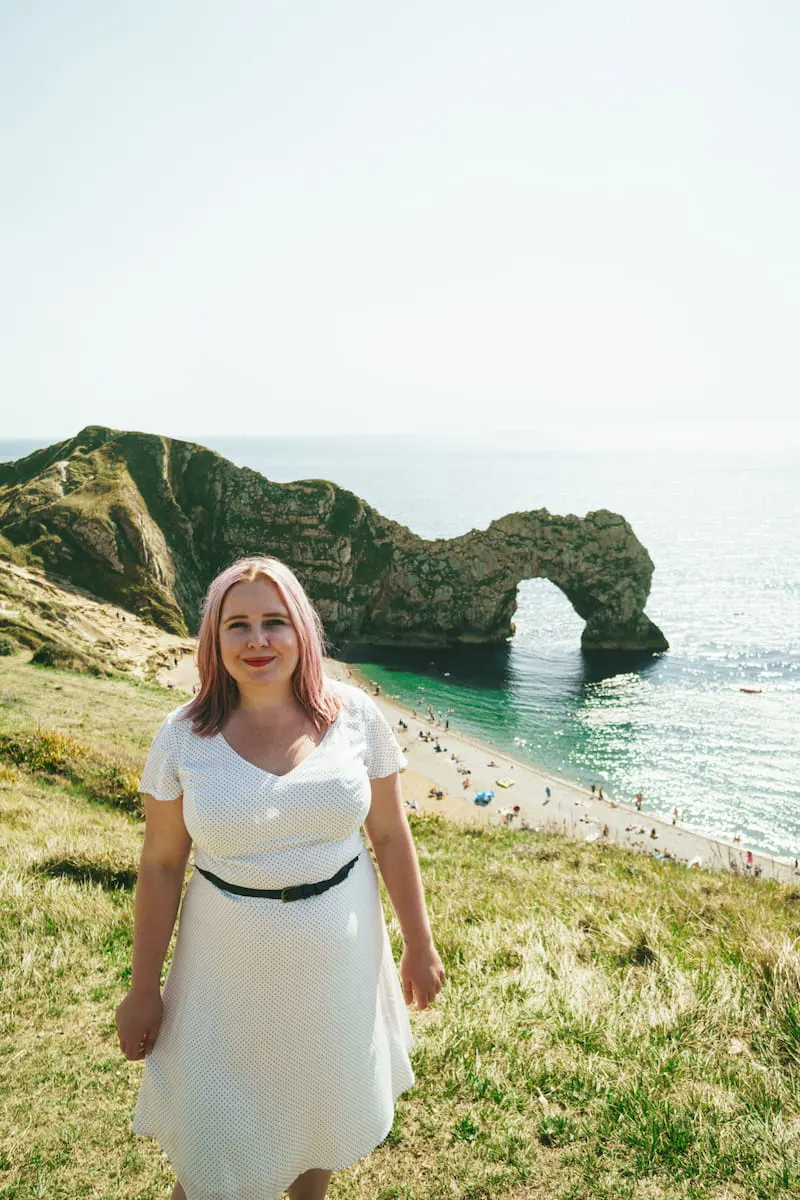
The view of Durdle Door in person has a major wow factor! Durdle Door is considered the world’s most famous rock arch and was formed 140 million years ago by the sea hitting the soft rock until it eroded down to the limestone. This limestone now stands almost vertically out of the sea and I like to think it actually looks like a dragon.
Tip: Visiting this area is not for those that are particularly afraid of heights!
You’ll want to have good shoes on as you follow the natural cliff path down to the right to Durdle Door Beach or to the left to Man O’War beach. And say hello to the sweet cows that are grazing on your way! Man O’War beach is where I’d recommend setting up for a few hours if you’re going to do some swimming or sunbathing. Its perfect crescent shape is viewed from the top, but you’ll have to hike quite a ways down to access the beach itself.
Durdle Door beach is where you’ll get the best views of the arch, but it’s a little busier and the water tends to be more choppy. However, both Man O’War and Durdle Door are pebble beaches with crystal clear water so you can’t go wrong.
Corfe Castle
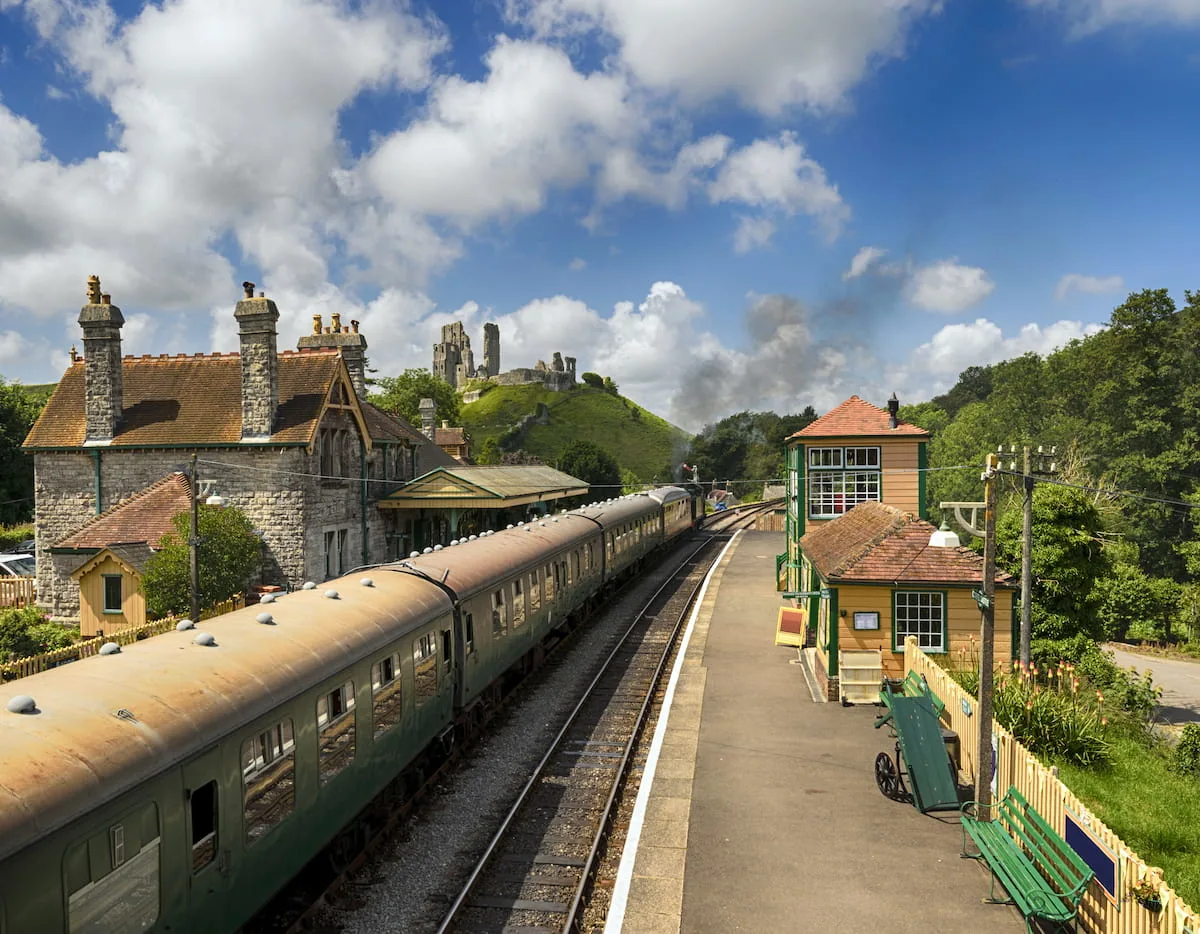
It’s about a 30-minute drive from Lulworth/Durdle Door to Corfe Castle. When I was first driving up to Corfe Castle I actually had no idea what it was. It was completely surreal, with this structure towering above in the distance. Once we got closer I was able to see the ruins of a castle built upon a steep hill. There are car parks across from the castle and you can hike up, or you can choose to park in the village and walk straight into the castle grounds from there. We chose to park in town.
The village of Corfe itself is completely medieval, constructed completely of local grey Purbeck limestone. It’s comprised of just East & West Streets that are linked at the north end by the square. Just off the square, you’ll find the entrance to Corfe Castle, a National Trust site.
The castle is over 1,000 years old, once a royal palace and fortress. Being one of the earliest castles in England to be built using partial stone, when all the others were still being built with timber and earth, Corfe Castle is one of Britain’s iconic survivors of the English Civil War. Unfortunately, it was partially demolished in 1646 by the Parliamentarians, but the castle still has a romantic vibe and breathtaking views across Purbeck.
There’s a humorous fast-paced audio experience placed throughout the grounds and included with entry that tells the story of Corfe Castle and life in it throughout the ages. Learn about kings, martyrs and heroines as you climb through the rocks and ruins and see what life must have been like from the high castle walls.
And if you’re lucky you’ll get to hear and watch the full-size passenger steam train go by! I felt like a little kid when I heard the whistle of the train as it was getting near. It was the perfect way to end our visit.
Old Harry Rocks
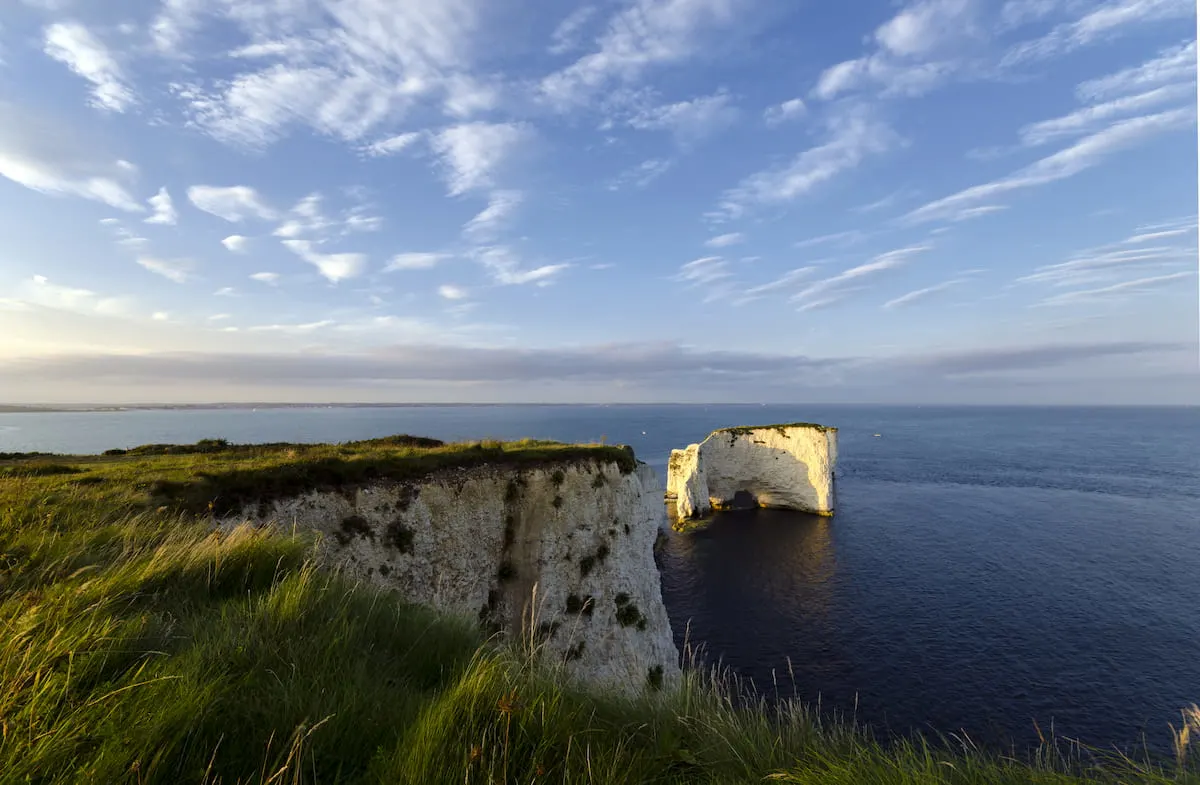
Other than Durdle Door, Old Harry Rocks is the most photographed area along the Jurassic Coast. These rocks were formed around 100 million years ago when skeletons and plankton began to drift to the bottom of the sea. And over the course of about 35 million years, this seemingly simple process actually formed a thick, white blanket of limestone, known as chalk. These are the pure white chalk formations you’ll see as Old Harry today.
You can’t miss the two white chalk stacks that mark the most eastern point of the Jurassic Coast. This whole area is protected by the National Trust. Of the two stacks, Harry is the smaller one farthest out at sea. A local legend of why the rock is called Harry is that one of Poole’s pirates, Harry Paye, was always hiding his ship behind the rocks while awaiting merchants to buy illegal goods from him. There are also other legends that say the devil used to lay on these rocks and that Harry used to have a wife, but she eroded into the sea over 100 years ago.
With Lulworth Cove and Old Harry Rocks being only an hour’s drive from each other, you can definitely see both in a day as I did, or you can spend the whole day hiking along this part of the coast. To reach Old Harry Rocks, there’s a car park at the Bankes Arms Pub in Studland and from there it’s about an hour walk.
Make sure and stop off for coffee, ice cream, or a sausage roll at a beach bar on your left heading to Old Harry or on the right on your way back. Here you can eat and drink right on the beach, kick your shoes off and watch all the boats and kayaks coming and going. I recommend a mocha!
Tyneham Village
Tyneham is a village with loads of character that sits to the east of Kimmeridge Bay and west of Lulworth Cove. Tyneham village is a pleasant mix of charming huts and country houses, with a traditional church smack dab in the middle of it. But what you won’t find in the coastal town are people. The village is completely deserted!
It can feel a bit eerie walking around this seeming ghost town, but it’s worth a visit to see Britain’s lost village. But I know the question you might be asking; why was Tyneham deserted?
Well back in 1943, on Christmas Eve of all days, this peaceful village and 7,500 acres of the surrounding heathland were taken by the War Office to help train Allied troops. As a result, the 252 inhabitants of the tiny Dorset village were only given mere days to pack all their belongings and leave their homes for good!
As they were leaving their home, the displaced families pinned a note to the Church door reading this…
Please treat the church and houses with care. We have given up our homes, where many of us have lived for generations, to help win the war and keep men free. We shall return one day and thank you for treating the village kindly.
Sadly in 1948 the village and surrounding land were compulsorily purchased and the inhabitants were never allowed to return. What was a temporary militarisation of the area became permanent and it’s still used for gunnery and other training to this day. As your drive into Lulworth Cove and Durdle Door, you can’t miss the military operations all around you.
But the ghost town of Tyneham is open to the public to visit on the weekends and it’s worth the views at Tyneham Beach as well.
Have you been inspired by the geology and history of the area of Lulworth Cove and Durdle Door? Is it worth visiting for a day, weekend or week? Absolutely! I hope you’ve found here that there’s so much to see and experience along the Jurassic Coast and it’s a must-visit destination in the UK.

Kat
Hi, I'm Kat, an Australian that moved to London in 2013 to start a new adventure. What a roller-coaster that was! I love helping others move to the UK and people explore the world! I’d be honoured if you’d say, “Thanks!” with a £3 coffee on Ko-fi.

